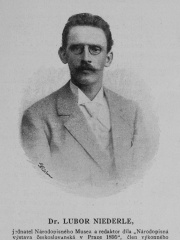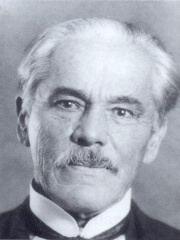

The Most Famous
ANTHROPOLOGISTS from Czechia
This page contains a list of the greatest Czech Anthropologists. The pantheon dataset contains 93 Anthropologists, 2 of which were born in Czechia. This makes Czechia the birth place of the 10th most number of Anthropologists behind Austria, and Poland.
Top 2
The following people are considered by Pantheon to be the most legendary Czech Anthropologists of all time. This list of famous Czech Anthropologists is sorted by HPI (Historical Popularity Index), a metric that aggregates information on a biography's online popularity.

1. Lubor Niederle (1865 - 1944)
With an HPI of 59.80, Lubor Niederle is the most famous Czech Anthropologist. His biography has been translated into 18 different languages on wikipedia.
Lubor Niederle (20 September 1865 – 14 June 1944) was a Czech archeologist, anthropologist and ethnographer. He is seen as one of the founders of modern archeology in Czech lands. He was born in Klatovy. He studied at the Charles University in Prague from 1883 to 1887. He was initially interested in classical archaeology, then studied anthropology, sociology and ethnology. Later, he studied in Munich under professor Johannes Rank (1889) and in Paris under professor Léonce Manouvriere at the École d’anthropologie. Niederle also travelled in several Slavic countries, studying archaeological findings and historical documents. In 1898 Niederle was named professor at the Charles University. As archaeologist he had represented the "university school" (univerzitní škola), opposed to the "museum school" (muzejní škola) represented by archaeologist Josef Ladislav Píč. During 1907–1908 Niederle served as a dean of Faculty of Philosophy, during 1908–1909 as a vice-dean and during 1927–1928 as a rector of the faculty. In 1919 he helped to establish State Archaeological Institute (Státní archeologický ústav), today's Institute of Archaeology (Archeologický ústav). He also published many articles about Slavic ethnography and archaeology and was editor of several specialised journals. Niederle had helped to set up Slavic Institute (Slovanský ústav) in Prague and directed it from 1928 until 1931. Among his most-known works are Handbook of Czech Archaeology (Rukověť české archeologie, 1910, with Karel Buchtela) and mainly the eleven-volume series Slavic Antiquities (Slovanské starožitnosti) published between 1902 and 1934. This series exhaustively investigated origin and prehistory of the Slavs, continuing earlier work by historian Pavel Josef Šafařík. Niederle died on 14 June 1944, in Prague.

2. Aleš Hrdlička (1869 - 1943)
With an HPI of 57.96, Aleš Hrdlička is the 2nd most famous Czech Anthropologist. His biography has been translated into 18 different languages.
Alois Ferdinand Hrdlička, after 1918 changed to Aleš Hrdlička (Czech pronunciation: [ˈa.lɛʃ ˈɦr̩d.lɪtʃ.ka]; March 30, 1869 – September 5, 1943), was a Czech-American anthropologist who lived in the United States after his family had moved there in 1881. He was born in Humpolec, Bohemia (today in the Czech Republic). Hrdlička was a pioneer in the field of anthropology and the first curator of physical anthropology of the Smithsonian Museum from 1904 until 1941. He believed in the theory that migration from Asia to the Americas via the Bering Strait was the origin of the American Indians, a migration he said had occurred not more than 3,000 years ago. He initially denied evidence by archaeological findings such as that of Folsom man in 1927 which pushed the date of human presence in the Americas back to more than 10,000 years ago.
People
Pantheon has 2 people classified as Czech anthropologists born between 1865 and 1869. Of these 2, none of them are still alive today. The most famous deceased Czech anthropologists include Lubor Niederle, and Aleš Hrdlička.

